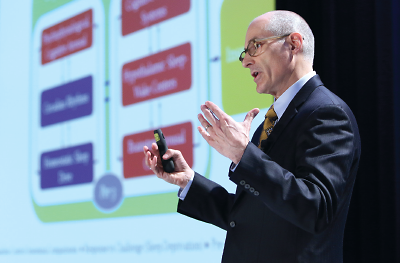Insomnia may be a disorder of neural network dysregulation across sleep/wake states, suggests Daniel Buysse, M.D., a professor of psychiatry at the University of Pittsburgh School of Medicine.
“We often think of sleep as an all or none phenomenon in the brain,” Buysse noted, “but not every part of the brain sleeps as deeply, or even at the same time, as other parts.”
Years of brain imaging studies by Buysse and his colleagues show that people with insomnia experience increased activity in several anatomically separate, but functionally linked, brain regions during the non-rapid eye movement (NREM) state of sleep.
Findings from brain imaging studies, Buysse said, may help account for some of the subjective experiences poor sleepers report.
He and his colleagues integrated findings from brain imaging studies with those from physiological and clinical studies in younger and older adults, with and without insomnia.
The researchers used standard polysomnography, for example, to examine nighttime sleep patterns in 35 adults with insomnia (mean age 68) and 27 adults without insomnia (also mean age 68). Adults with insomnia, as expected, reported more difficulty sleeping.
The researchers then kept both groups of study participants awake for 36 consecutive hours. Every two hours, they gave subjects a brief opportunity to sleep, using a standard protocol for assessing sleepiness, the Multiple Sleep Latency Test. If the subjects fell asleep, they were awakened after 90 seconds. If they did not fall asleep within 20 minutes, the trial was terminated. This procedure allowed researchers to assess participants’ levels of sleepiness over the 36 hours of extended wakefulness. The researchers also measured subjects’ core body temperature and melatonin to track daily rhythms of sleepiness and wakefulness.
Both groups proved strikingly similar. The longer they were awake, the sleepier they got. “That’s an important finding,” Buysse told Psychiatric News, “because prior studies suggested that people with insomnia are less sleepy than people without insomnia. We did not find that people with insomnia were either more or less sleepy than controls.” Also, both groups were sleepiest around 3 a.m., roughly the midpoint of a usual night’s sleep, indicating normal circadian rhythmicity.
When allowed to sleep undisturbed, both groups experienced more intense deep sleep, as is characteristic of recovery sleep.
People with insomnia differed from controls in one subtle way: their core body temperature was about 0.20 degrees C higher on average at all times of day across the entire 36-hour waking portion of the study.
The higher their temperature, the worse they said they slept, according to their scores on the Insomnia Severity Index, a symptom checklist. Elevated temperature may be a potential marker for insomnia, Buysse said, as it suggests a disturbance of autonomic nervous system function.
In another study, Buysse’s group recruited 37 younger adults (mean age 37.1) with insomnia and 30 people without insomnia (mean age 38.3) to receive positron emission tomography (PET) scans while they were awake and during NREM sleep. The researchers then compared the groups’ regional brain metabolism while awake and during NREM.
People without insomnia experienced a substantial decrease in metabolism in parts of the default mode network, executive control network, and salience network in NREM sleep compared with wakefulness. People with insomnia, however, showed no change or a small increase in metabolism in these networks in NREM sleep compared with wakefulness.
These networks, Buysse noted, play a role in ruminative thinking, detecting stimuli in one’s environment, and higher mental and cognitive processing.
People with insomnia often say their minds won’t turn off, and report remaining aware of noises and other activities in their surroundings, even while they sleep. The PET findings, Buysse said, may provide a brain correlate of these symptoms.
In another study, older adults with insomnia participated in six individual, approximately weekly sessions of cognitive-behavioral therapy for insomnia (CBT-I), the first-line insomnia treatment.
After completing CBT-I, they again were kept awake for 36 consecutive hours. They fell asleep faster than they did before therapy. Their average body temperature did not change, however, suggesting elevated temperature may be a persistent trait.
A night of sleep deprivation helps people with insomnia, Buysse said, by driving networks that usually are driven offline with sleep further offline. Sleep deprivation thus enables people with insomnia to sleep better the next time they sleep. PET scan studies conducted in younger adults with insomnia, he said, suggest that a night of sleep deprivation decreases brain activity in the networks mentioned above, helping to normalize network state regulation.
Effective treatments for insomnia do that, too, Buysse said. PET scans show that CBT-I, as well as benzodiazepine receptor agonists, help to normalize regional metabolism in one or more brain networks related to self-awareness, cognitive control during sleep, and salience detection.
CBT-I has been shown to be highly efficacious for both primary insomnia and insomnia accompanying psychiatric and medical disorders, Buysse added.
“CBT-I techniques are relatively straightforward for psychiatrists to use with patients,” he said. “Improving patients’ sleep may improve their psychiatric and medical illnesses, as well.” ■
“The Pathophysiology of Insomnia” can be accessed
here.

